Resin-bound surfaces significantly outperform resin-bonded options in extreme heat. A properly installed resin-bound surface typically lasts 20-25 years with minimal maintenance, much like a well-built garden patio. The material stays firm and stable even during British heatwaves, whilst resin-bonded surfaces tend to soften and become tacky in high temperatures, lasting only 8-15 years. If you’re based in a sun-exposed area, such as a south-facing driveway, resin-bound is clearly the more durable choice.
Key Takeaways
Resin-bound surfaces are the clear winner when it comes to extreme heat resistance. They keep their shape and strength remarkably well, much like a well-made pavement that stays firm even on the hottest summer days. With basic care, they’ll last 20-25 years.
Resin-bonded surfaces don’t fare nearly as well in the heat. Think of them like chocolate left in the sun – they can become soft and sticky when temperatures soar, leading to cracks. Their lifespan is notably shorter at 8-15 years.
The maintenance difference is substantial. While resin-bound surfaces might need a major touch-up after two decades, resin-bonded surfaces require significant repairs much sooner, often within 8-15 years. It’s similar to the difference between a quality tarmac drive and a basic gravel one – the better initial investment pays off in the long run.
For UK property owners dealing with increasingly warm summers, resin-bound surfaces offer better value and reliability. They’re the more sensible choice for long-term durability in hot weather.
Understanding Resin-Bound and Resin-Bonded Surfaces
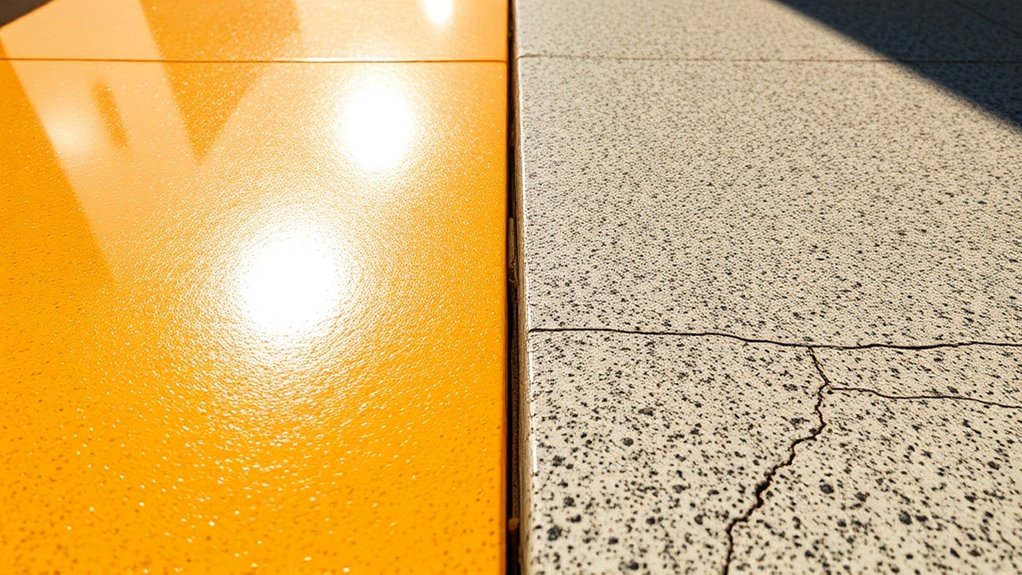
Resin-bound and resin-bonded surfaces offer distinct characteristics for different outdoor applications.
A resin-bound surface blends resin and aggregate together thoroughly – think of mixing cake ingredients – creating a smooth, modern finish. You’ll need a permeable base, much like a garden path foundation, and the result is a surface that lets rainwater drain through naturally. This permeability enhances environmental impact by allowing water to filter through and reduce flooding risks. These surfaces are particularly effective for areas that experience heavy foot traffic, as they provide durability along with their aesthetic appeal.
Resin-bonded surfaces work differently. The resin acts like glue, with loose stones scattered on top, giving you something similar to a traditional gravel driveway but with firmly fixed stones.
It’s ideal for non-porous bases and provides excellent grip, particularly useful for sloped driveways or areas with heavy foot traffic.
Both options come in various colours and stone sizes, but resin-bound surfaces deliver a smoother, more polished look – perfect for contemporary garden paths or patio areas.
The bonded version suits properties where a more rustic, textured finish works better with the surroundings.
Durability in High Temperatures
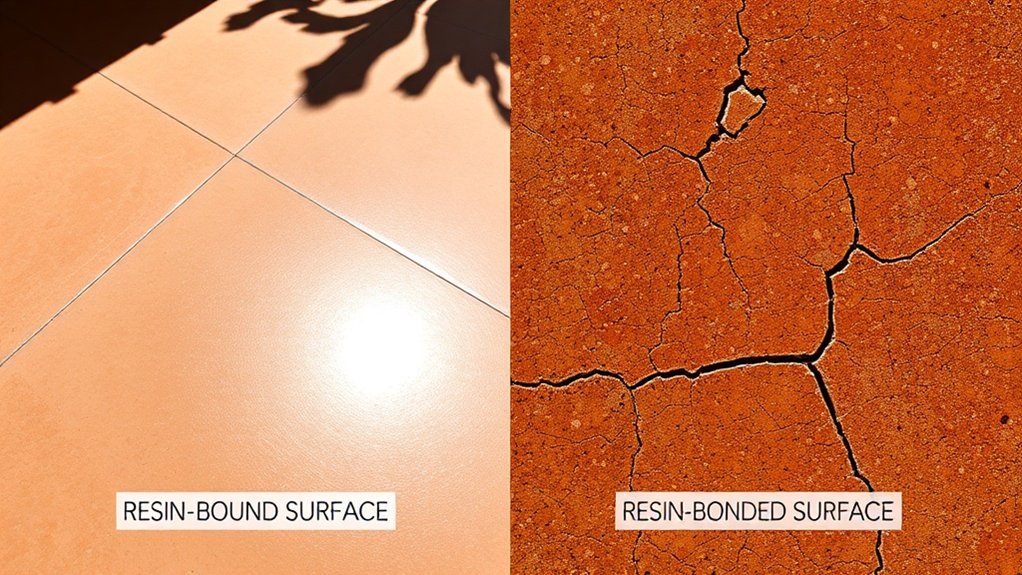
Durability in High Temperatures
Resin-bound and resin-bonded surfaces handle hot weather quite differently, much like comparing a breathable running vest to a thick plastic raincoat.
Resin-bound surfaces:
- Stay cooler thanks to their permeable structure, like a garden path that lets water through
- Handle heat stress better due to their porous nature
- Keep their shape and strength even on scorching summer days, making them ideal for residential driveways, as they typically last longer with proper quality materials.
Resin-bonded surfaces:
- Trap heat like tarmac on a hot day
- Can become soft and sticky in extreme heat
- Often develop small cracks that worsen over time
For UK summers, which are becoming increasingly warm, resin-bound surfaces prove more reliable and need less upkeep.
Think of them as the more sensible choice for long-term durability in our changing climate.
Material Composition and Its Impact on Longevity
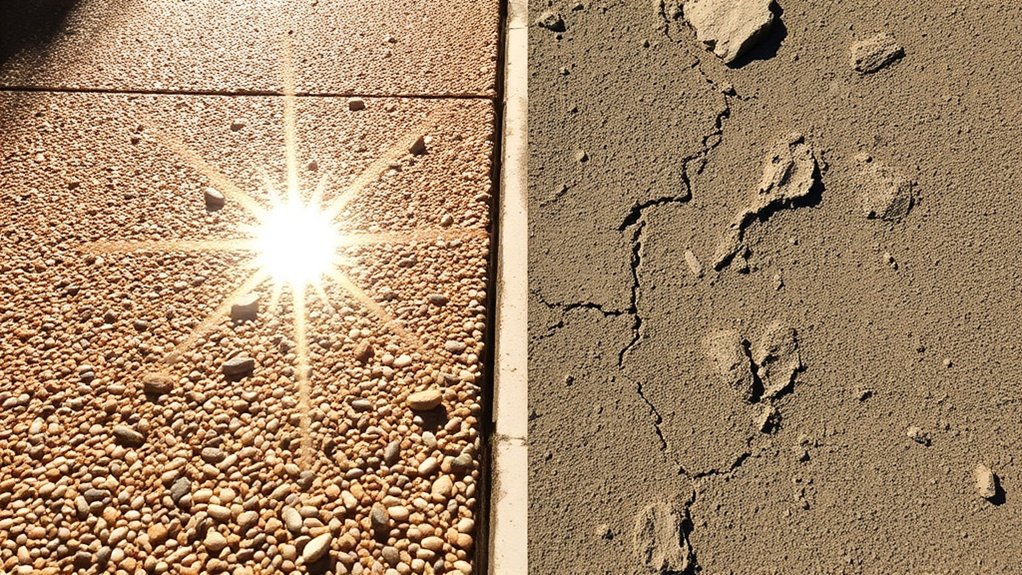
The makeup of resin surfaces significantly affects how long they last. When comparing resin-bound and resin-bonded options, their composition tells quite different stories.
| Feature | Resin-Bound | Resin-Bonded |
|---|---|---|
| Aggregate Encapsulation | Fully coated by resin | Loosely scattered on resin |
| Bond Strength | Stronger bond | Weaker bond |
| Permeability | Porous, allows drainage | Non-permeable, seals moisture |
| Flexibility | High due to additives | Lower, prone to cracking |
| Aggregate Size | Smaller, uniformly graded | Larger, rougher |
Think of resin-bound surfaces like a well-knitted jumper – everything’s tightly woven together. Resin-bonded surfaces are more like stones glued to a surface; they might come loose over time. Resin-bound surfaces cope better with British weather, draining rainwater efficiently whilst staying intact during summer heat. In contrast, resin-bonded surfaces tend to trap moisture and can crack during temperature changes, much like poorly laid concrete paths. The permeability characteristics of resin-bound surfaces prevent water from pooling, thus enhancing their longevity in extreme heat. Additionally, resin-bound surfaces’ durability significantly reduces the need for frequent maintenance throughout varying weather conditions.
Heat Resistance: A Comparison
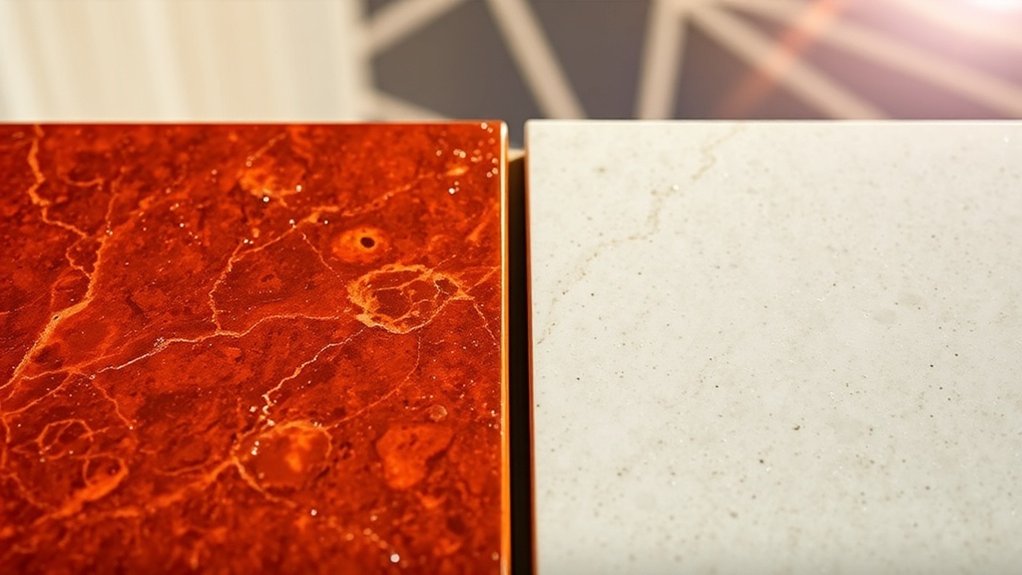
Heat Resistance: A Comparison
Resin surfaces react quite differently to heat, with significant variations between resin-bound and resin-bonded options.
Resin-bound surfaces:
- Handle heat well by letting warmth and moisture escape naturally
- Flex with temperature changes, reducing cracks
- Last about 20-25 years with minimal upkeep
Resin-bonded surfaces:
- Hold onto heat, much like a car park on a hot summer’s day
- Tend to flake and crack when exposed to prolonged heat
- Need more frequent repairs due to poor drainage
For British weather conditions, resin-bound surfaces prove more practical.
Think of them like a breathable raincoat – they let heat and moisture pass through, whilst resin-bonded surfaces act more like a plastic sheet, trapping everything underneath.
The choice is particularly important for driveways and patios that catch direct sunlight.
Permeability and Its Role in Surface Durability
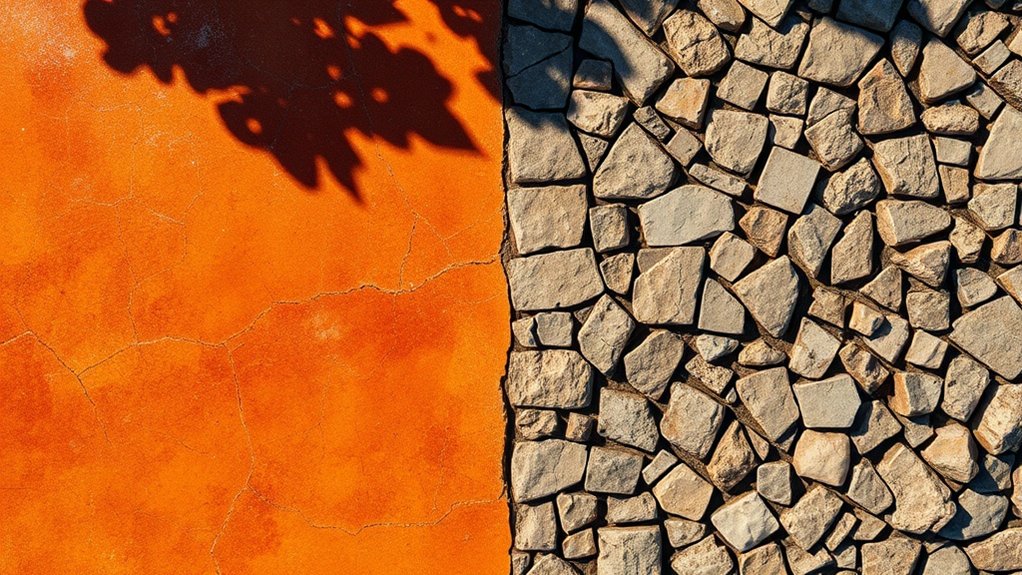
Permeability is crucial for surface durability, particularly in extreme weather. Resin-bound surfaces excel here, as their porous structure lets water drain away naturally – much like a sponge absorbing water. This helps prevent issues like surface cracking when water freezes and expands during cold snaps.
Unlike their bound counterparts, resin-bonded surfaces don’t allow water through, leading to puddles that can damage the surface when temperatures soar. Think of it like a blocked drain – with nowhere to go, water sits on top and causes problems. Without proper drainage, you’ll likely see flaking and wear much sooner than expected.
Choosing a permeable resin-bound surface is a practical way to extend your surface’s lifespan. It’ll handle both British summers and winters better, keeping its structure sound for years to come.
For our UK climate, good permeability isn’t just nice to have – it’s essential for a lasting surface.
Maintenance Needs for Extreme Heat Conditions

High temperatures can cause resin surfaces to flake more readily as the material reacts to heat changes.
Regular upkeep and swift repairs are vital to maintain surface quality and stop severe damage developing.
Quick action helps save money and keeps resin surfaces in good condition for longer.
Flaking and Repair Frequency
Understanding Flaking and Repairs
Resin surfaces react differently to Britain’s variable weather, particularly during our increasingly warm summers. The key differences are quite straightforward:
- Flaking patterns: Resin-bound surfaces stay largely intact, whilst resin-bonded ones tend to shed stones and flake, rather like a poorly laid garden path.
- Repair timing: You’ll typically get 15-25 years from a resin-bound surface before major repairs are needed. Resin-bonded surfaces often need fixing every 8-15 years, about as often as you’d resurface a standard driveway.
- Upkeep needs: Resin-bound surfaces are relatively fuss-free.
Resin-bonded ones need more frequent check-ups, especially after hot spells when the surface can become unstable.
Long-Term Cost Efficiency
The maintenance costs of resin surfaces in hot weather make a significant difference to your bottom line. A thorough cost breakdown reveals that resin-bound surfaces offer better value for money, thanks to their robust nature and minimal upkeep needs.
Much like a well-built house, resin-bound systems handle temperature changes and sun exposure brilliantly, cutting down on repair costs. Think of resin-bonded surfaces as requiring the same attention as a weathered garden fence – they need regular resealing and fixes due to wear and tear. Over time, these repeated repairs on resin-bonded surfaces pile up the costs.
In contrast, resin-bound surfaces, whilst pricier upfront, prove more cost-effective long-term – similar to investing in quality double-glazing. For areas experiencing intense heat, resin-bound surfaces are clearly the smarter financial choice.
Performance Under Thermal Cycling
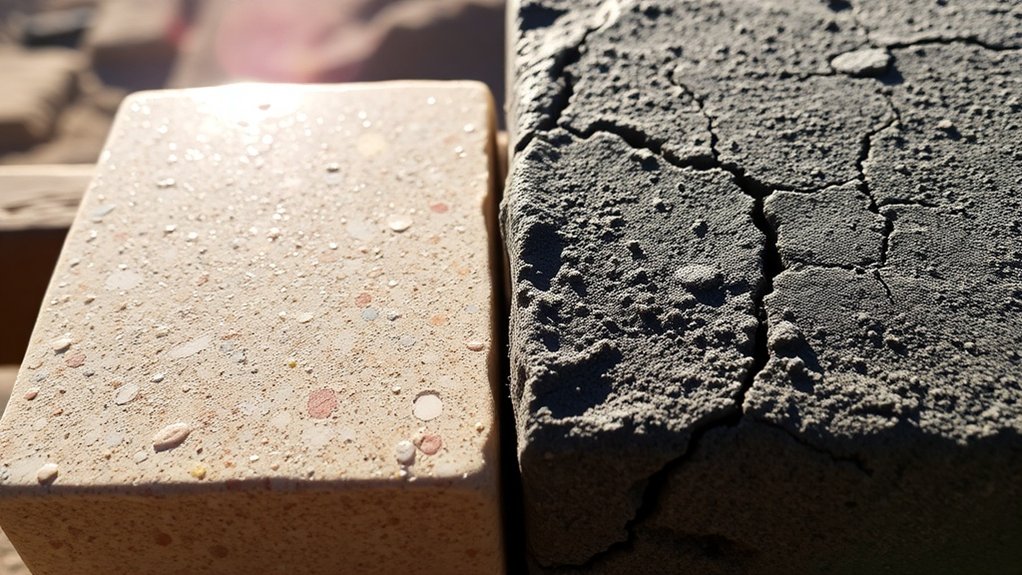
Performance Under Thermal Cycling
Different surfaces react uniquely to temperature changes, much like how a garden patio expands and contracts between hot summer days and frosty mornings.
These temperature shifts affect how long the surface lasts and how well it performs.
- Resin-bound surfaces stay stable because their mixture of resin and stone is evenly blended, rather like a well-mixed cake batter. This helps prevent uneven expansion.
- Resin-bonded surfaces tend to crack and flake as the materials expand and contract at different rates, similar to how old paint peels off walls.
- Thermoplastic polyurethane resin works brilliantly in resin-bound surfaces because it bends and flexes with temperature changes, much like a rubber band.
Effects of Weather Extremes on Surface Types

Different weather conditions can seriously affect how surfaces perform, especially here in the UK.
Resin-bound surfaces work well in our climate because they’re permeable – meaning water can drain through them rather than forming puddles. This helps prevent damage during our frequent freeze-thaw cycles.
Resin-bonded surfaces aren’t permeable, which can be problematic in British weather. When rainwater can’t drain away, it sits on top or gets trapped underneath, leading to cracks when temperatures drop below freezing.
While these surfaces cope well with UV exposure during our summer months, they can become brittle over time.
The key is choosing the right surface for our weather patterns. For example, a resin-bound driveway will handle heavy rain better than a resin-bonded one, making it more practical for typical British conditions.
Suitability for High-Traffic Areas in Hot Climates
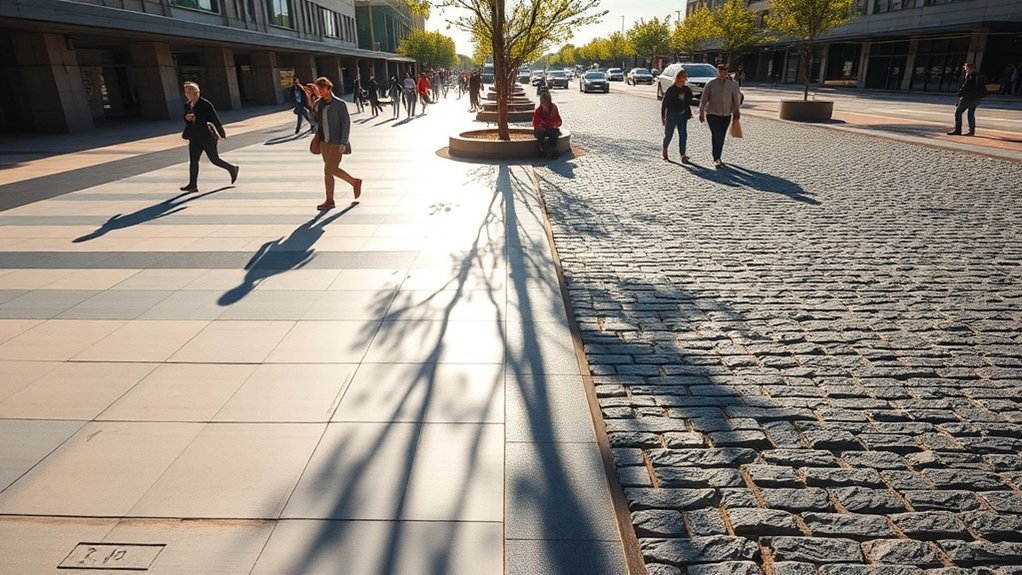
Resin surfaces for busy areas in hot weather need careful consideration.
Resin-bound paving stands up well to heavy foot traffic and vehicles, creating a smooth, durable finish that won’t break down in the heat.
Think of busy shopping centres or car parks – these spaces need tough surfaces that last.
Resin-bonded options tend to wear down faster, especially when the sun beats down and lots of people are walking on them.
For the best results in hot British summers, resin-bound is typically the smarter choice.
Durability Under High Heat
Heat Performance Comparison
Resin-bound and resin-bonded surfaces handle hot weather quite differently, which matters if you’re planning to use them in sunny, high-traffic spots.
Resin-bound surfaces:
- Use flexible aliphatic resins that bend rather than break in the heat (think of a rubber band versus a plastic ruler)
- Let water drain through naturally, preventing heat build-up
- Ideal for places like shopping centre car parks or sunny garden paths
Resin-bonded surfaces:
- Less flexible and more rigid structure
- Tend to crack and peel in hot conditions
- Best suited for shaded areas or regions with moderate temperatures
For British summers, both options work well, but resin-bound surfaces prove more reliable during those occasional heatwaves we’ve been seeing more frequently.
Traffic Load Resistance
Traffic load resistance proves crucial when choosing surfaces for busy areas, particularly in warm weather.
Resin-bound surfaces handle weight distribution brilliantly, thanks to their uniform mixture of aggregate and resin. This means they keep their shape well under constant use, like in car parks or busy walkways.
Resin-bonded surfaces aren’t as robust – their loose stones can shift about and wear down, leaving uneven patches that need fixing. Large lorries and frequent traffic make matters worse, often causing the surface to chip and wear out faster than expected.
Though resin-bonded surfaces start off with good grip, they wear unevenly in high-traffic spots, becoming slippery over time.
Resin-bound surfaces, however, maintain steady performance throughout their life, making them the smarter choice for heavily used areas in hot conditions.
Think of busy shopping centre car parks or town centre pavements – these spaces need surfaces that can take a proper beating day after day.
Environmental Considerations for Surface Selection
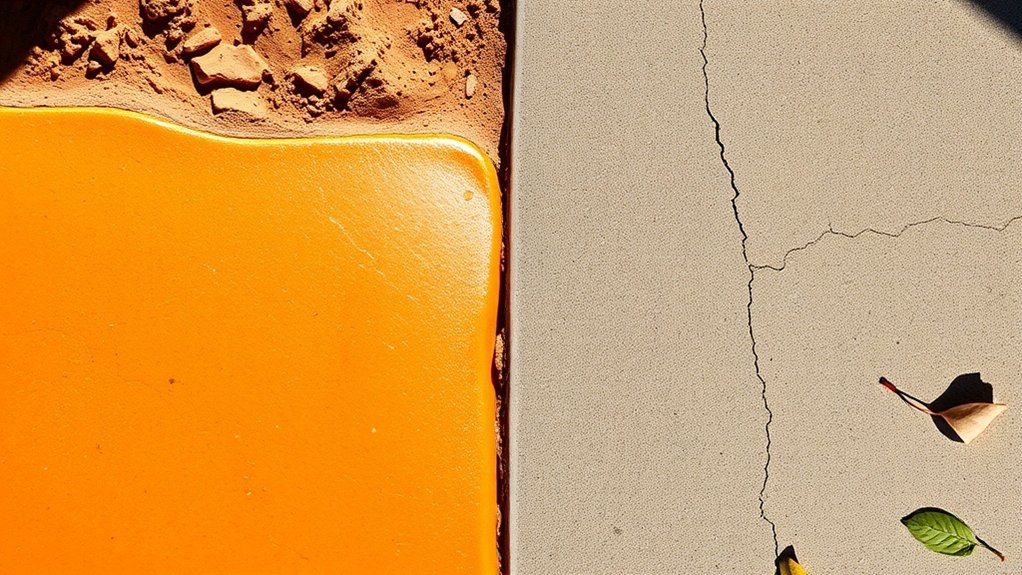
Choosing surface materials for heat-exposed areas demands careful thought about environmental impact. When comparing resin-bound and resin-bonded surfaces:
Permeability
Resin-bound surfaces allow water to drain naturally, much like a garden path, helping prevent flooding during heavy British rainfall.
Heat Management
The breathable nature of resin-bound surfaces helps cool surrounding areas – think of it like a stone patio that doesn’t get scorching hot in summer.
Materials
Both options use natural stone and aggregate mixtures, similar to traditional gravel but with better staying power. This reduces the need for artificial materials whilst meeting UK building standards.
Resin-bound surfaces prove particularly suitable for British weather, offering both heat resistance and proper drainage.
They’re a practical choice for anyone keen on sustainable building practices, especially in urban areas where water management is crucial.
Cost Implications of Maintenance and Longevity
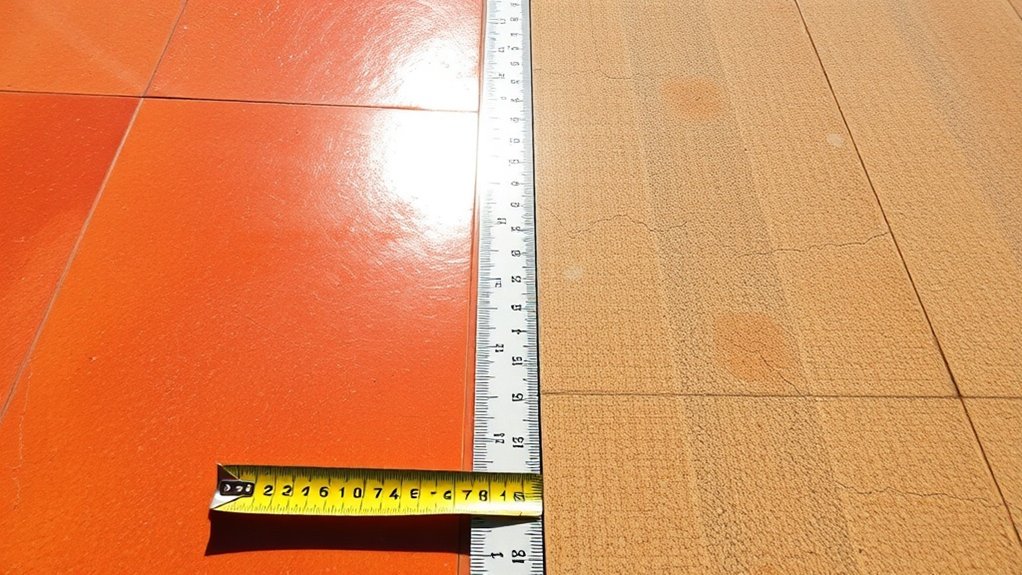
Cost Impact: Maintenance and Longevity of Resin Surfaces
Choosing between resin-bound and resin-bonded surfaces comes down to balancing immediate costs against long-term value. Think of it like buying a quality washing machine versus a budget model – the cheaper option often costs more in repairs over time.
Resin-bonded surfaces offer a cheaper initial outlay at £15-£30 per square metre but need weekly maintenance to stay in good nick. In contrast, resin-bound surfaces cost more upfront (£50-£100 per square metre) but require only monthly upkeep, making them more cost-effective over time.
| Surface Type | Initial Cost (per m²) | Maintenance Frequency | Estimated Lifespan |
|---|---|---|---|
| Resin Bonded | £15 – £30 | Frequent (weekly) | 25 – 50 years |
| Resin Bound | £50 – £100 | Minimal (monthly) | 30 – 50 years |
The higher initial investment in resin-bound surfaces typically pays off through reduced maintenance costs and slightly longer lifespan. For busy homeowners or commercial properties, this means less time and money spent on upkeep in the long run.
Making an Informed Decision for Hot Climate Applications
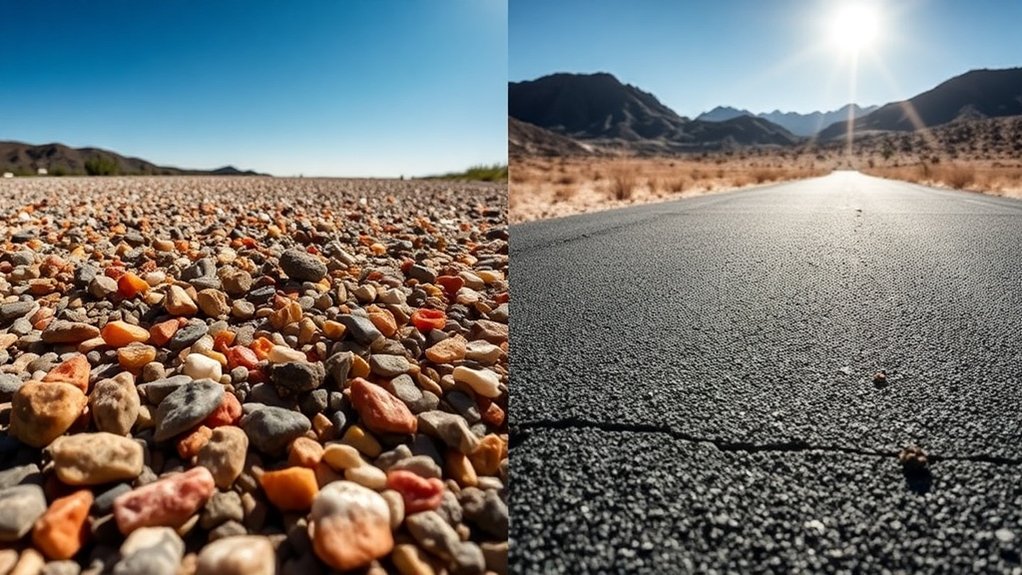
Choosing the Right Surface Material for Hot Weather
When selecting surface materials for hot climate use in the UK, compare resin-bound and resin-bonded options carefully:
- Durability: Resin-bound surfaces stand up better to heat and UV rays, much like a quality garden decking that doesn’t warp in summer.
- Water Handling: Think of resin-bound surfaces as breathable sportswear – they let heat escape. Resin-bonded surfaces, like a plastic raincoat, trap heat and risk damage.
- Looks: Resin-bound keeps its colour in strong sun, whilst bonded surfaces tend to fade like an old garden chair.
Proper installation is crucial – it’s like laying a patio; get it wrong, and you’ll face problems later.
Match your choice to local weather patterns, foot traffic and grip requirements. A well-chosen surface should last years, even during British heatwaves.
Frequently Asked Questions
How Do Resin-Bound and Resin-Bonded Surfaces Differ in Installation Requirements?
Resin-bound and resin-bonded driveways require quite different bases for proper installation. Resin-bound surfaces, much like a sponge, need a porous foundation to allow rainwater to drain through naturally. Think of your typical garden path base. Resin-bonded, however, must sit on solid, non-porous surfaces – similar to how tarmac needs a firm foundation. The prep work varies significantly between the two, which directly affects how long they’ll last and how much upkeep they’ll need down the line.
What Aesthetic Options Are Available for Resin-Bound Versus Resin-Bonded Surfaces?
Resin-bound surfaces come in a vast range of colours and deliver a smooth, polished look – rather like a premium patio finish. Resin-bonded surfaces offer a more traditional, gravelly texture that’s similar to a well-maintained driveway. Both systems hold their colour brilliantly over time, though resin-bound surfaces give you more creative freedom with patterns and designs. The choice often comes down to whether you prefer a contemporary, seamless appearance or a classic, textured finish.
Can Resin-Bound Surfaces Be Repaired if Damaged?
Resin-bound surfaces are indeed repairable when damaged. For minor issues like small cracks or chips, a matching resin mix can be applied to patch the affected area. Larger damage might require cutting out the damaged section and laying fresh resin. Most repairs need dry conditions and proper temperatures (above 5°C) to cure properly – much like when your bathroom sealant needs replacing. A professional can match the original aggregate and colour, ensuring the repair blends seamlessly with the existing surface.
Do Environmental Factors Affect the Choice Between Resin-Bound and Resin-Bonded?
Climate impact plays a crucial role in your surfacing choice. Resin-bound surfaces cope well with British weather, offering excellent drainage during heavy rain and maintaining stability in summer heat. Resin-bonded might struggle in extreme temperatures, particularly during hot spells, where surface loosening becomes more likely.
What Are the Typical Costs Associated With Resin-Bound and Resin-Bonded Surfaces?
Resin-bound surfaces cost between £70-£120 per m², whilst resin-bonded surfaces come in at £50-£70 per m². The higher price of resin-bound systems often proves worth the investment, as they tend to last longer and need less upkeep than their bonded counterparts. Think of it like choosing between a basic and premium driveway finish – you’ll pay more upfront for the premium option, but it could save money over time.
Conclusion
Resin-bound surfaces generally outperform resin-bonded ones in extreme heat conditions. The key difference lies in how they’re constructed: resin-bound surfaces mix the aggregate throughout the resin, much like a cake mixture, whilst resin-bonded surfaces simply stick the aggregate on top, similar to sprinkling seeds on bread.
Think of a car park in summer – a resin-bound surface maintains its integrity even when temperatures soar, whereas resin-bonded surfaces can soften and become tacky. This is because resin-bound surfaces distribute heat more evenly through their structure.
For British summers, where temperatures can unexpectedly spike, resin-bound surfaces prove more reliable and require less maintenance. The higher initial cost typically pays off through better longevity and fewer repairs.
